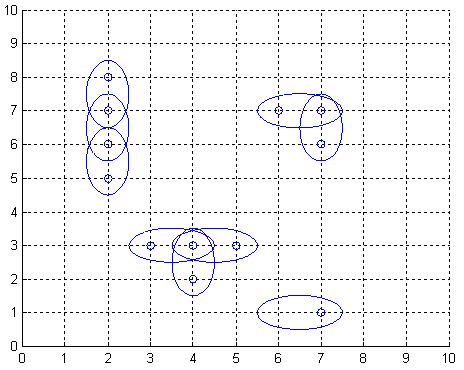Written by razrlele
19:27 August 14, 2018
|
Antenna Placement
Description The Global Aerial Research Centre has been allotted the task of building the fifth generation of mobile phone nets in Sweden. The most striking reason why they got the job, is their discovery of a new, highly noise resistant, antenna. It is called 4DAir, and comes in four types. Each type can only transmit and receive signals in a direction aligned with a (slightly skewed) latitudinal and longitudinal grid, because of the interacting electromagnetic field of the earth. The four types correspond to antennas operating in the directions north, west, south, and east, respectively. Below is an example picture of places of interest, depicted by twelve small rings, and nine 4DAir antennas depicted by ellipses covering them.
 Obviously, it is desirable to use as few antennas as possible, but still provide coverage for each place of interest. We model the problem as follows: Let A be a rectangular matrix describing the surface of Sweden, where an entry of A either is a point of interest, which must be covered by at least one antenna, or empty space. Antennas can only be positioned at an entry in A. When an antenna is placed at row r and column c, this entry is considered covered, but also one of the neighbouring entries (c+1,r),(c,r+1),(c-1,r), or (c,r-1), is covered depending on the type chosen for this particular antenna. What is the least number of antennas for which there exists a placement in A such that all points of interest are covered? Input On the first row of input is a single positive integer n, specifying the number of scenarios that follow. Each scenario begins with a row containing two positive integers h and w, with 1 <= h <= 40 and 0 < w <= 10. Thereafter is a matrix presented, describing the points of interest in Sweden in the form of h lines, each containing w characters from the set [‘*’,’o’]. A ‘*’-character symbolises a point of interest, whereas a ‘o’-character represents open space. Output For each scenario, output the minimum number of antennas necessary to cover all ‘*’-entries in the scenario’s matrix, on a row of its own.
Sample Input
Sample Output
Source |
思路
注意理解题意,每一个antennas只能除了当前坐标以外再cover住上下左右四个点中的一个点,另外就是有关一个定理:最大独立子集是最小覆盖集的补集。
这道题求的是最小路径覆盖:
最小路径覆盖=最大独立子集=\(G\)-最大匹配数
\(G\)是所有定点个数,依旧是套匈牙利算法模版。
代码
|
1 2 3 4 5 6 7 8 9 10 11 12 13 14 15 16 17 18 19 20 21 22 23 24 25 26 27 28 29 30 31 32 33 34 35 36 37 38 39 40 41 42 43 44 45 46 47 48 49 50 51 52 53 54 55 56 57 58 59 60 61 62 63 64 65 66 67 68 69 70 71 72 73 74 75 76 77 78 79 80 81 82 83 84 85 86 87 88 89 90 91 92 93 94 95 96 97 98 99 100 101 102 103 104 105 106 107 108 109 110 111 112 113 114 115 116 117 118 119 120 121 122 123 124 125 126 127 128 129 130 131 132 |
/* * File Name: poj3020.cpp * Author: razrLeLe * Mail: razrlele@gmail.com */ #include <vector> #include <set> #include <deque> #include <queue> #include <algorithm> #include <functional> #include <iostream> #include <cstdio> #include <cmath> #include <cstdlib> #include <string> #include <cstring> #include <string.h> #include <map> #include <cctype> #include <list> #include <stack> #define ll long long using namespace std; #define INF 0x3f3f3f3f #define LOCAL int n, h, w; const int max_h = 50; const int max_n = 40*10+10; int num; int G[max_n][max_n]; int M[max_h][max_h]; int vis[max_n]; int linked[max_n]; int uN, vN; bool dfs(int u){ for(int v = 1; v <= vN; v++){ if(!vis[v] && G[u][v]){ vis[v] = true; if(linked[v] == 0 || dfs(linked[v])){ linked[v] = u; return true; } } } return false; } int hungarish(){ int ans = 0; memset(linked, 0, sizeof(linked)); for(int i = 1; i <= uN; i++){ memset(vis, 0, sizeof(vis)); if(dfs(i)){ ans++; } } return ans; } void build_graph(int i, int j){ for(int i2 = i-1; i2 <= i+1; i2++) for(int j2 = j-1; j2 <= j+1; j2++) { if(!(i2 == i && j2 == j) && (i == i2 || j == j2) && M[i2][j2] > 0){ G[M[i][j]][M[i2][j2]] = 1; } } return ; } void solve() { scanf("%d %d", &h, &w); getchar(); char c; num = 0; for(int i = 0; i < h; i++ ){ memset(M[i], 0, sizeof(int)*w); } for(int i = 0; i < max_n; i++){ memset(G[i], 0, sizeof(int)*max_n); } for(int i = 0; i < h; i++){ for(int j = 0; j < w; j++){ c = getchar(); if(c == '*'){ M[i][j] = ++num; } } getchar(); } uN = num; vN = num; for(int i = 0; i < h; i++) for(int j = 0; j < w; j++) if(M[i][j] > 0) build_graph(i, j); int match = hungarish(); // printf("test %d\n", match); printf("%d\n", num-match/2); //match/2 是因为这个图是个无向图 return ; } int main(int argc, char ** argv) { #ifdef LOCAL freopen("/Users/razrlele/build/in.data", "r", stdin); //freopen("/Users/razrlele/build/out.data", "w", stdout); #endif scanf("%d", &n); getchar(); while(n--){ solve(); } return 0; } |